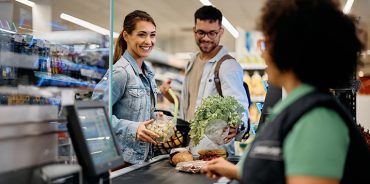The Future of Retail Innovation
In the fast-moving world of retail, being ‘fit for the future’ requires innovation. Customers are demanding more digital, contactless, personal, convenient and safer shopping experiences – and it’s important for retailers to strike the right note.
In order to create meaningful innovation for customers, retailers need to really understand what’s relevant, how the market is developing and what the organisation can successfully deliver. To do this, they must focus on solving the biggest problems for customers – exploring these customer pain points is undoubtedly the best starting point for determining the best innovation strategies.
By listening to and combining the trio of voices – customers, market, company – retailers can diagnose challenges and opportunities and respond accordingly to influence customer experience, perception and behaviour, which will ultimately drive sales.
Anticipating trends
There are few – if any – retailers who can win against the large multinationals on price alone. Savvy retailers use other tools in the box: exclusive or local brands, or a personalised and more efficient shopping experience.
Retailers can fill gaps in the market overlooked by national brands, add innovation into new product categories and encourage customer loyalty by stocking a unique or exclusive product range.
US grocer Raley’s, in pursuit of its vision to change how the world eats for healthier, happier lives, took steps to evolve into a healthier shopping environment, positioning baskets of free fruit at the store entrance for children, revamping the checkout stands with healthier snacks and removing sugary and artificial drinks. Raley’s efforts hit the mark; recent dunnhumby research found that shoppers expect retailers – rather than government – to play a role in supporting them to lead a healthy lifestyle.
Elsewhere in North America, retailer Kroger, aware that convenience and speed of shop are ever important for customers, increased spending and boosted loyalty by shortening the time to check out in its stores with the Scan, Bag, Go initiative – a customer-first innovation that made a difference.
Disruptive innovation
Timing is also critical to impactful innovation. When UK retailer Tesco launched its Red Door initiative, it was to take a new approach to disruptive innovation and stay ahead of customer needs.
Red Door established a single hub where new products, ideas or emerging technologies could get in front of the Group Innovation team. It provided an easy way to share ideas and sought to implement innovations that would create a competitive advantage for the brand, and saw the launch of innovative brands, products and services alongside the introduction of new technologies and systems.
One key partnership to emerge from the initiative was with Wicked Kitchen, whose co-founder, Derek Sarno, wanted to bring the brand’s philosophy to supermarket shelves: ‘if you eat 80% healthy and 20% wicked, then you are 100% awesome’. Sarno’s goal was to help thousands of people to make healthy, plant-based choices, while Tesco was keen to tap into the fast-growing plant-based market – currently valued at around £2 billion in the UK. It’s a partnership that has brought significant success to all involved, and crucially, has been well-received by Tesco customers.
Don’t simply chase ‘shiny new things’
Whether it’s opening your organisation up to new ideas or simply looking at where your competitors are achieving greater sales, innovation always need to put the customer at the heart of every decision. It’s easy to get distracted by shiny new things and disruptive technology, but it’s only by following and anticipating customer needs at every step that retailers can truly count on successful innovation.
TOPICS
RELATED PRODUCTS
Amplify Customer understanding to create strategies that drive results
Customer First solutionsThe latest insights from our experts around the world



